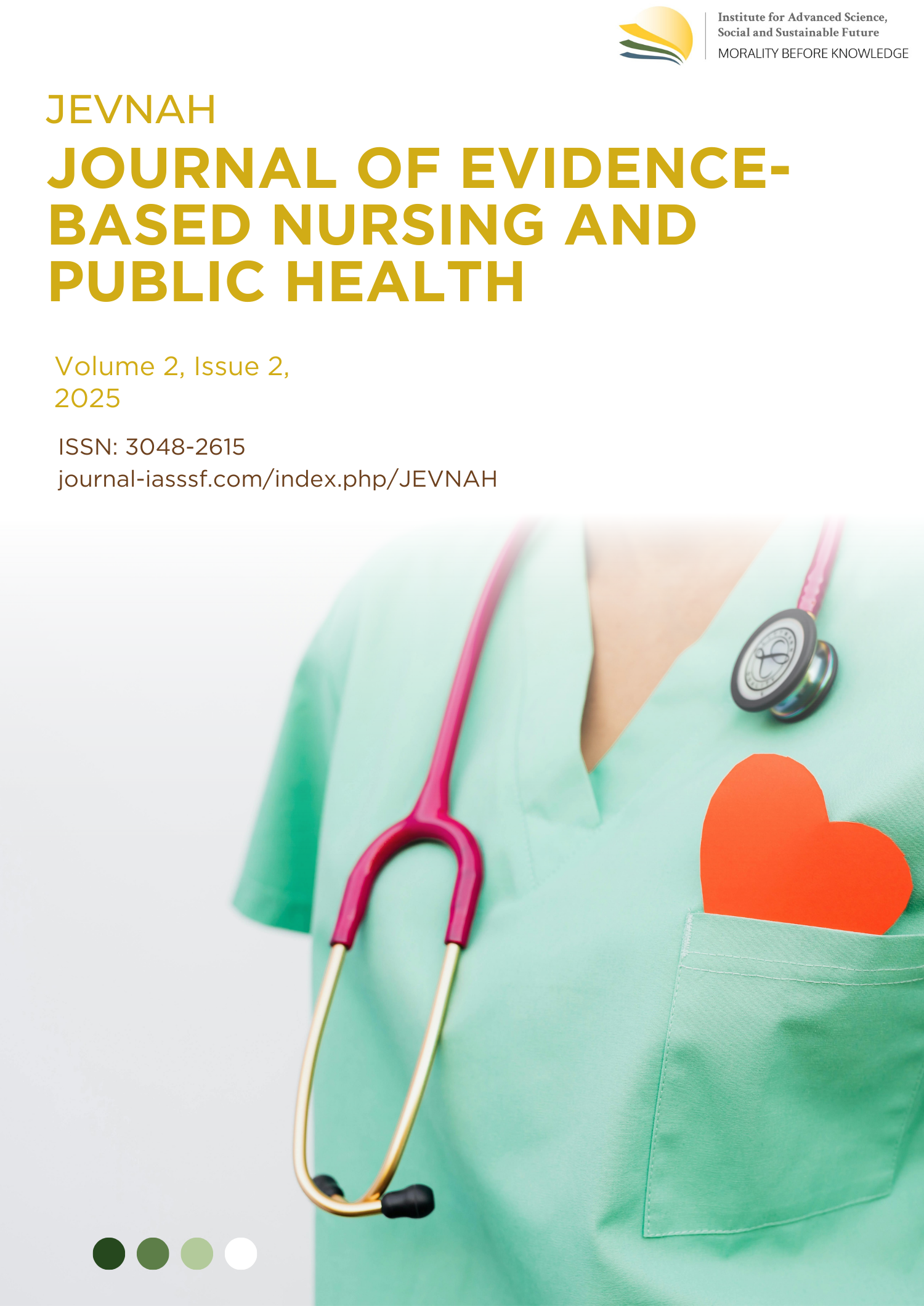Stability analysis of Monkeypox virus transmission dynamics using the SEIVR approach
DOI:
https://doi.org/10.61511/jevnah.v2i02.2025.1837Keywords:
monkeypox, SEIVR model, stability analysisAbstract
Backgorund: Monkeypox is a zoonotic infection caused by the monkeypox virus (MONKEYPOXV), which has the potential to be transmitted from animals to humans. This virus can be transmitted through direct contact with infected animals such as monkeys, rats, and squirrels. In 2023, the World Health Organization classified monkeypox as a global pandemic, prompting stricter prevention measures worldwide. Given the significant increase in the number of cases and the challenges in controlling the spread of the virus, this study aims to develop a SEIVR (Susceptible, Exposed, Infected, Vaccinated, Recovered) mathematical model that can describe the dynamics of the spread of the monkeypox virus in Indonesia. Methods: There are two cases of the SEIVR model that will be studied; those are disease-free and endemic cases. From the cases, the stability of the model will be found. The Routh-Hurwitz criterion will also be used to analyze the stability due to the complexity of the eigenvalues. Findings: In the study conducted, simulations indicated that the infected population would coexist or remain for a fairly long time. This phenomenon is caused by the stable nature of the model. The dynamics of the model can also be seen by considering the obtained reproductive number. Although the infected population persists for a long time, the numbers are quite low. Conclusion: Vaccination does not have a significant impact. Therefore, further research using a treatment compartment or virus transition in rodents needs to be conducted for further study. Novelty/Originality of this Article: The novelty of this research lies in the use of the SEIVR model to map the spread of monkeypox in Indonesia and analyze its stability using the Routh-Hurwitz criteria and numerical simulations. This approach provides an initial overview of case persistence and vaccination effectiveness.
References
Al-Shomrani, M. M., Musa, S. S., & Yusuf, A. (2023). Unfolding the transmission dynamics of monkeypox virus: an epidemiological modelling analysis. Mathematics, 11(1121), 1-21. https://doi.org/10.3390/math11051121
Alakunle, E., Moens, U., Nchinda, G., & Okeke, M. I. (2020). Monkeypox virus in nigeria: Infection biology, epidemiology, and evolution. Viruses, 12(11), 1–29. https://doi.org/10.3390/v12111257
Antara. (2024). Indonesia Reports 88 Monkeypox Cases, Majority Recovered. jakartaglobe.id
Bhunu, C. P., & Mushayabasa, S. (2011). Modelling the transmission dynamics of pox-like infections. IAENG International Journal of Applied Mathematics, 41(2), 141–149. https://www.iaeng.org/IJAM/issues_v41/issue_2/IJAM_41_2_09
Buana, G. (2024). WHO Berencana Mengucurkan Dana Senilai Rp2,1 Triliun untuk Atasi Wabah Mpox. Media Indonesia.
Caldwell, J., & Ram, Y. M. (1999). Mathematical Modelling (Vol. 6). Springer Netherlands. https://doi.org/10.1007/978-94-017-2201-8
CDC. (2022). Mpox in the United States and Around the World: Current Situation. CDC.
Elsonbaty, A., Adel, W., Aldurayhim, A., & El-Mesady, A. (2024). Mathematical modeling and analysis of a novel monkeypox virus spread integrating imperfect vaccination and nonlinear incidence rates. Ain Shams Engineering Journal, 15(3), 102451. https://doi.org/10.1016/j.asej.2023.102451
Farahat, R. A., Abdelaal, A., Shah, J., Ghozy, S., Sah, R., Bonilla-Aldana, D. K., Rodriguez-Morales, A. J., McHugh, T. D., & Leblebicioglu, H. (2022). Monkeypox outbreaks during COVID-19 pandemic: are we looking at an independent phenomenon or an overlapping pandemic? Annals of Clinical Microbiology and Antimicrobials, 21(1), 26. https://doi.org/10.1186/s12941-022-00518-2
Gruber, M. F. (2022). Current status of monkeypox vaccines. Npj Vaccines, 7(1), 1–3. https://doi.org/10.1038/s41541-022-00527-4
Harris, E. (2022). What to Know About Monkeypox. JAMA, 327(23), 2278–2279. https://doi.org/10.1001/jama.2022.9499
Huang, Y., Mu, L., & Wang, W. (2022). Monkeypox: epidemiology, pathogenesis, treatment and prevention. Signal Transduction and Targeted Therapy, 7(373), 1-22. https://www.nature.com/articles/s41392-022-01215-4
Idisi, O. I., Yusuf, T. T., Adeniyi, E., Onifade, A. A., Oyebo, Y. T., Samuel, A. T., & Kareem, L. A. (2023). A new compartmentalized epidemic model to analytically study the impact of awareness on the control and mitigation of the monkeypox disease. In Healthcare Analytics (Vol. 4).
https://doi.org/10.1016/j.health.2023.100267
Jairoun, A. A., Al-Hemyari, S. S., Abdulla, N. M., El-Dahiyat, F., Shahwan, M., Hassan, N., Jairoun, O., Alyousef, N. G., Sharif, S., & Jaber, A. A. S. (2022). Awareness and preparedness of human monkeypox outbreak among university student: Time to worry or one to ignore? Journal of Infection and Public Health, 15(10), 1065–1071. https://doi.org/10.1016/j.jiph.2022.08.015
Kesuma, A. S. ., Zalma, N. R., Hudzaifah, J., & Djatmiko, E. M. (2022). Tinjauan Literatur : Analisis Efektivitas Tecovirimat dan Cidofovir pada Pasien Monkeypox. Jurnal Kedokteran dan Kesehatan, 11(5), 1057–1064.
https://ejurnalmalahayati.ac.id/index.php/kesehatan/article/view/14761/0
Letafati, A., & Sakhavarz, T. (2023). Monkeypox virus: A review. Microbial Pathogenesis, 176, 1-7. https://doi.org/10.1016/j.micpath.2023.106027
Lu, J., Xing, H., Wang, C., Tang, M., Wu, C., Ye, F., . . . Shen, L. (2023). Mpox (formerly monkeypox): pathogenesis, prevention and treatment. Signal Transduction and Targeted Therapy, 8(458), 1-15.
https://www.nature.com/articles/s41392-023-01675-2
Marisah, Hilmi, I. L., & Salman. (2022). Studi Dan Tatalaksana Terkait Penyakit Cacar Monyet (Monkeypox) Yang Menginfeksi Manusia. Jurnal Farmasetis, 11(3), 201–208.
Mortoja, S. G., Panja, P., & Mondal, S. K. (2018). Dynamics of a predator-prey model with stage-structure on both species and anti-predator behavior. Informatics in Medicine Unlocked, 10, 50–57. https://doi.org/10.1016/j.imu.2017.12.004
Musafir, R. R., Suryanto, A., Darti, I., & Trisilowati. (2024). Optimal control of a fractional-order monkeypox epidemic model with vaccination and rodents culling. Results in Control and Optimization, 14, 100381.
https://doi.org/10.1016/j.rico.2024.100381
Noman, Z. Al, Tasnim, S., Masud, R. I., Anika, T. T., Islam, M. S., Rahman, A. M. M. T., & Rahman, M. T. (2024). Reverse-zoonosis: Global impact and changes in transmission patterns. Journal of Advanced Veterinary and Animal Research, 11(3), 601–617. https://doi.org/10.5455/javar.2024.k810
Nurfadilah, Hikmah, & Fardinah. (2021). ANALISIS MODEL MATEMATIKA PENYEBARAN PENYAKIT ISPA. Journal of Mathematics: Theory and Applications, 14–22. https://doi.org/10.31605/jomta.v3i1.1373
O’Laughlin, K., Tobolowsky, F. A., Elmor, R., Overton, R., O’Connor, S. M., Damon, I. K., Petersen, B. W., Rao, A. K., Chatham-Stephens, K., Yu, P., Yu, Y., & CDC Monkeypox Tecovirimat Data Abstraction Team. (2022). Morbidity and Mortality Weekly Report Clinical Use of Tecovirimat (Tpoxx) for Treatment of Monkeypox Under an Investigational New Drug Protocol-United States, May-August 2022. Morbidity and Mortality Weekly Report, 71(37), 1190–1195. https://www.cdc.gov/poxvirus/monkeypox/pdf/Tecovirimat-IND-Protocol-
Okyere, S., & Ackora-Prah, J. (2023). Modeling and analysis of monkeypox disease using fractional derivatives. Results in Engineering, 17, 100786. https://doi.org/10.1016/j.rineng.2022.100786
Patauner, F., Gallo, R., & Durante-Mangoni, E. (2022). Monkeypox infection: An update for the practicing physician. European Journal of Internal Medicine, 104(August), 1–6. https://doi.org/10.1016/j.ejim.2022.08.022
Putri Gumandang, H. (2022). MONKEYPOX DISEASE: WABAH MULTI-NASIONAL. Jurnal Kesehatan Saintika Meditory, 5(1), 30.
https://doi.org/10.30633/jsm.v5i1.1425
Qelina, L., & Graharti, R. (2019). Human Monkeypox Virus : Respon Kesiapan Darurat Dunia akan Wabah Infeksi Virus Monkeypox. Medula, 9(3), 483–489. https://www.academia.edu/70337416/Human_Monkeypox_Virus_Respon_Kesiapan_Darurat_Dunia
Saputra, H., Salma, N., & Anjari, S. R. (2022). Monkeypox transmission risks in Indonesia. Public Health of Indonesia, 8(3), 68–74.
https://doi.org/10.36685/phi.v8i3.634
Sari, M., & Hairunisa, N. (2022). A Review of the Monkeypox Outbreak in Indonesia in 2022. Jurnal Kedokteran Diponegoro, 11(5), 268-274.
https://ejournal3.undip.ac.id/index.php/medico/article/view/35895
Side, S. (2020). Analysis and Simulation of SIRI Model for Dengue Fever Transmission. Indian Journal of Science and Technology, 13(3), 340–351.
https://doi.org/10.17485/ijst/2020/v13i03/147852
Sweilam, N. H., Mohammed, Z. N., & Abdel Kareem, W. S. (2024). Numerical approaches for solving complex order monkeypox mathematical model. Alexandria Engineering Journal, 90, 170–182.
https://doi.org/10.1016/j.aej.2024.01.061
Tamara, T. (2021). Gambaran Vaksinasi COVID-19 di Indonesia pada Juli 2021 (Overview of COVID-19 Vaccination in Indonesia in July 2021). Medula, 11(1), 180–183. https://www.journalofmedula.com/index.php/medula/article/view/255
Thornhill, J. P., Barkati, S., Walmsley, S., Rockstroh, J., Antinori, A., Harrison, L. B., Palich, R., Nori, A., Reeves, I., Habibi, M. S., Apea, V., Boesecke, C., Vandekerckhove, L., Yakubovsky, M., Sendagorta, E., Blanco, J. L., Florence, E., Moschese, D., Maltez, F. M., … Orkin, C. M. (2022). Monkeypox Virus Infection in Humans across 16 Countries — April–June 2022. New England Journal of Medicine, 387(8), 679–691. https://doi.org/10.1056/NEJMoa2207323
World Health Organization. (2022). Multi-country monkeypox outbreak: Situation update. WHO.
Wireko, F. A., Adu, I. K., Sebil, C., & Asamoah, J. K. K. (2023). A fractal–fractional order model for exploring the dynamics of Monkeypox disease. Decision Analytics Journal, 8, 100300. https://doi.org/10.1016/j.dajour.2023.100300
Downloads
Published
Issue
Section
Citation Check
License
Copyright (c) 2025 Glagah Eskacakra Setyowisnu, Isnu Aji Saputro, Mohamad Izudin Fikri, Rahayu Nur Rahmawati, Ade Bagus Ramdhanu

This work is licensed under a Creative Commons Attribution 4.0 International License.
















